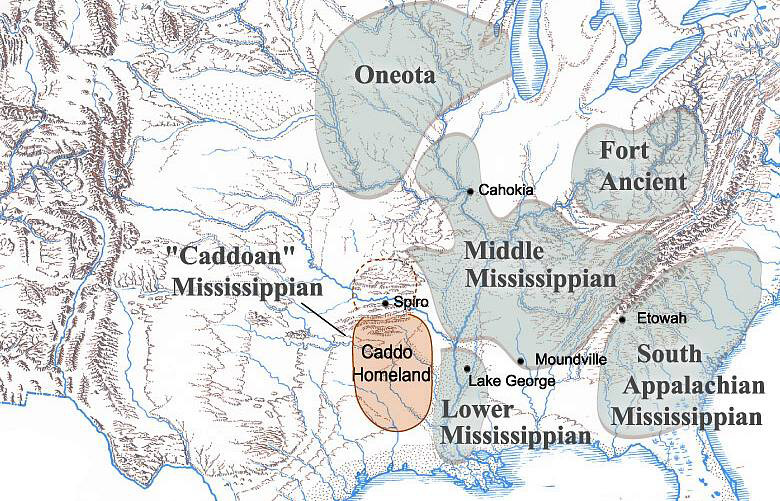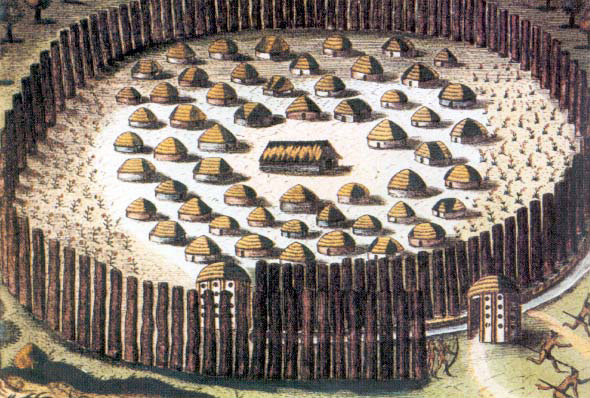Aaittafama' Archaeological Park History
Native Peoples and the Cumberland River Valley
Middle Tennessee has been inhabited for more the 15,000 years by a succession of peoples. With no written records, archaeologists have given names to each culture period. The Paleo-Indian period was 12,000 to 8000 BCE, Archaic period 8000 to 1000 BCE, Woodland period, 1000 BCE to 1000 CE, and Mississippian, 1000 to 1500 CE. The Mississippian peoples are considered ancestral to the Creek and Chickasaw tribes of the historic period.
The Mississippians
The Mississippian Indian civilization thrived in upper middle Tennessee for almost 600 years. After studying common cultural traits associated with this civilization, anthropologist William Henry Holmes designed the term “Mississippian” to refer to the people of this region. There were two distinctive physiographic regions related to Mississippian settlement in the area: the Nashville Basin and the surrounding Highland Rim. Evidence shows that the region was connected culturally to the lower Cumberland-Tennessee River line, creating a unified historic resource available for study today. Light to heavy scatterings of ceramic and other deposits, including structural remains in the form of houses, mounds, and burials, have been discovered along numerous rivers and other large streams in Middle Tennessee.
 |
The Mississippians had no writing system or stone architecture. A unique characteristic evolved, however, in the manufacturing of pots and other vessels, which these items were tempered with crushed mussel shells. At the time, mussels were abundant in many of the region’s major rivers including the Tennessee, Cumberland, Elk, Harpeth, and Duck rivers. The use of shells helped to date the era of significance to post 1100 CE. These items give us a window into understanding a complex pattern of social relations that formed in towns and other communities as distinctive features of Mississippian culture.
Mississippian Settlement and Subsistence
Mississippian settlements were characterized by five different patterns: mound complex, farming village, hamlet, farmstead, and limited activity loci. Along the Cumberland River and its tributaries, the major sites appeared to be separated by 20 to 40 miles. Smaller sites and farmsteads were clustered near the major mound complexes. A social network existed between these locations that offered both protection and trade. The Nashville area was one of the most heavily populated Mississippian settlements. One of the largest was the Sulphur Springs area, just north of the Tennessee state capitol. This community specialized in producing salt from mineral rich spring water because it was a valuable trade commodity.
Unlike contemporary humans, Mississippian people spent much of their lives outdoors. The houses they built were used for shelter from inclement or cold weather months, and storage. These structures were primarily rectangular or circular pole structures. Individual holes or continuous trenches were excavated to set the poles. Walls were made by weaving saplings and river cane around the poles, and the outer surface of the walls was sometimes covered with sun-baked clay or daub. Roofs were thatch covered with a small hole cut in the middle to allow smoke to escape. A hearth dominated the center of the living space, and benches were used as beds. The interior was also used for storage, usually along the outer walls, while short partitions divided this outer area into separate spaces. The average Mississippian house was less than 400 square feet.
 |
Mississippians were agriculturalists. They grew much of their foodstuffs in small gardens using simple tools such as stone axes, digging sticks, and fire. Corn, beans, squash, sunflowers, goosefoot, sumpweed, and other plants were cultivated throughout the year.
Intensive archaeological investigations in East and Middle Tennessee have yielded one of the most detailed records of prehistoric human-plant interaction in eastern North America. Ongoing paleoethnobotanical research has documented the presence of Cucurbita (the botanical genus containing the various squashes) in Middle Tennessee 7,000 years ago. This is one of the three earliest occurrences of Cucurbita in North America (all dating between 6,900 and 7,100 years ago).
Research into the ecology and expression of genetic change in plants under cultivation has documented the domestication of certain “weeds,” and their maintenance as garden or field crops by at least 1000 BCE and perhaps as early as 2000 BCE. Examples include the common lambs quarter or goosefoot, sunflower, and sumpweed or marsh elder. Archaeological and botanical evidence also suggest that maygrass, a spring-maturing annual which today is not common in Tennessee,was being cultivated as early as 1800 BC. Although its use began in the Woodland Period, corn agriculture flourished in the Mississippian Period and became the basis of their economy.
Mississippians also consumed wild plants and animals. They gathered nuts and fruits and hunted deer, turkeys, and other small animals as well as collected and consumed fish, shellfish, and turtles from rivers, streams, and ponds. There were no bison in Middle Tennessee in Mississippian times, as they arrived around 1600 CE.
The Mound Builders
Early historic travelers in the South East encountered old town sites with large earthen mounds. Contemporary Indians did not know who had built them. The erroneous idea emerged that they were created by an extinct race of Mound Builders. Archaeologists now know they were constructed by Native people. These mounds served both ceremonial and dwelling purposes and contain multiple layers. Not all towns contained mounds, one such example is the Aaittafama’ site. At the end of the Mississippian period, the town had houses surrounded by a vertical log palisade, which was likely for protection from other groups. Frequently, the houses contained stone lined graves of children, and adults were buried in separate cemeteries. This distinctive mode of burial is limited to Middle Tennessee.
